- Starting at under $70,000, the 2025 Audi RS 3 is the least expensive RS car you can buy.
- It pulled 1.00 g of lateral grip on our skidpad, but failed to match its claimed 0-60 time.
- A front set of carbon-ceramic brakes and sticky Bridgestone tires improve its braking distance.
Tested: 2025 Audi RS 3 Is Like a Reverse Mullet
Party up front, business in the back
Every now and then, you'll encounter a car you truly want to love but simply can't. That was the 2022 Audi RS 3 when I drove it a few years ago. A little pocket rocket with tons of power, an interesting engine, and what should've been the perfect recipe for tackling a twisty mountain road. Unfortunately, the sum of its parts was greater than the whole. Its steering was devoid of feedback, its engine sounded completely muffled, and it lacked the precision you'd expect from a car wearing an RS badge.
Thankfully, it seems Audi agrees, so when it came time to refresh the RS 3 for the 2025 model year, it implemented changes to improve these areas rather than going the predictable route of giving it more power and calling it a day. As such, the RS 3 gets a tweaked rear differential, revised suspension calibration, and a new Bridgestone Potenza Sport tire, promising sharper handling. Do they deliver?
2025 Audi RS 3
2025 Audi RS 3 | Edmunds Test Results |
|---|---|
| Engine | turbo 2.5-liter inline-five |
| Power | 394 hp |
| Torque | 369 lb-ft |
| Transmission | seven-speed dual-clutch automatic |
| Driveline | AWD |
| Weight | 3,614 pounds |
| 0-60 mph | 3.8 seconds |
| Quarter mile | 12 seconds @ 112.6 mph |
| 60-0 mph braking | 105 mph |
| Lateral grip (200-foot skidpad) | 1.00 g |
| Price as tested | $75,000 (est.) |
The pocket rocket comes alive (sort of)
One of the first things you'll notice when you walk up to the Audi RS 3 is just how much wider its front track is than its rear. Parked up at our test track, its 265/30/19 tires seemingly want to poke out of the already widened fenders, tucking neatly thanks to plenty of negative camber. Its 245/35/19 rears, however, stand up perfectly straight and have no issues hiding behind the narrow quarter panels surrounding them.
Think of the RS 3 as a backwards mullet: party up front, business in the back. It's a persona that solidifies itself the second you get it on the track. Get moving at a decent pace, and you'll experience tremendous grip from its front end with those wide Bridgestones holding on well. It was enough for this 2025 RS 3 to manage 1.0 g of lateral grip on our skidpad, outdoing the 2022 model's 0.96 g figure, achieved on a set of less grippy Pirelli P Zeros.
Push closer to the RS 3's and it comes alive in a way the pre-facelift model never could. Instead of throwing its hands in the air and defaulting to understeer, the updated car's revised differential sends more power to the rear outside tire in a bend. This helps the little Audi rotate better into and out of corners and gives it a slightly more playful character at higher speeds.
Unfortunately, some of the pre-face-lift model's ailments remain. Its steering, while quick and precise, lacks any sort of feedback. Paired with this set of whisper-quiet Bridgestones, it's hard to tell when you're brushing up on the front end's grip limit as its steering weight never shifts to warn you.
Simultaneously, the noises from its inline-five engine come from its speakers, not its massive exhaust tips. It's a shame because Audi's rendition of a half-Lamborghini V10 sliced is one of the most interesting powertrains on sale, especially as performance cars become more homogenous. If only we could fully enjoy its soundtrack.
Down on power, but who cares?
The RS 3's inline-five is down on power over the pre-face-lift model, mainly due to regulations across the pond. This brings its horsepower output down to 394 hp from 401 hp, while its 369 lb-ft of torque figure remains unchanged. Can you feel it in the real world? Absolutely not. However, the numbers tell a slightly different story.
This refreshed model matches the 2022's 1.5-second time to 30 mph, although it's already a tenth of a second behind when it hits 60 mph, posting a 3.8-second time versus its predecessor's best run. The 2022 RS 3 retains its lead through the quarter mile, completing the run in 11.9 seconds, while the 2025 model is a tenth slower at 12 seconds flat.
However, the most significant difference is their trap speeds, with the new car crossing the line at 112.6 mph while the old model moving quicker at 114.9 mph. So while you likely won't be doing top-speed runs regularly, owners of the older model can take solace in knowing that it's a hair quicker, even if it isn't quite as exciting to drive. You also won't be doing many top-speed runs, as I found out at the Edmunds test track, where this RS 3 needed some cooldown runs to get its launch control system to reengage.
As measured on our scales, the latest RS 3 weighs 3,614 pounds with a full gas tank, undercutting Audi's claimed weight figure. This tester came equipped with carbon-ceramic brakes up front and a conventional set of steel brakes in the rear. Still, it allowed for a 105-foot stopping distance from 60 mph, falling just 1 foot behind a BMW M2 with steel brakes and besting the 2022 RS 3 by the same amount. It's worth noting that achieving that figure required multiple runs as the Audi's ceramics need some temperature before they're ready to perform.
Sure, its soft suspension and quiet cabin hurt its on-track performance and force you to hear its glorious inline-five through synthetic speaker sounds, but the RS 3 might be one of the most compelling daily drivers I've ever tested. I just wish it transferred the same excitement to the test track.





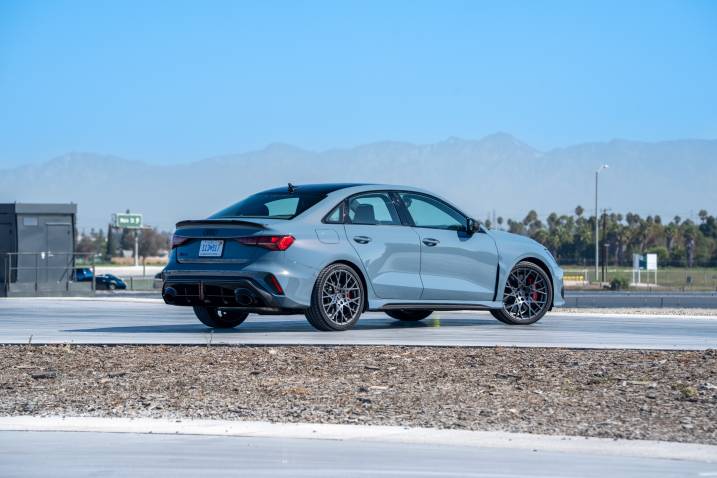
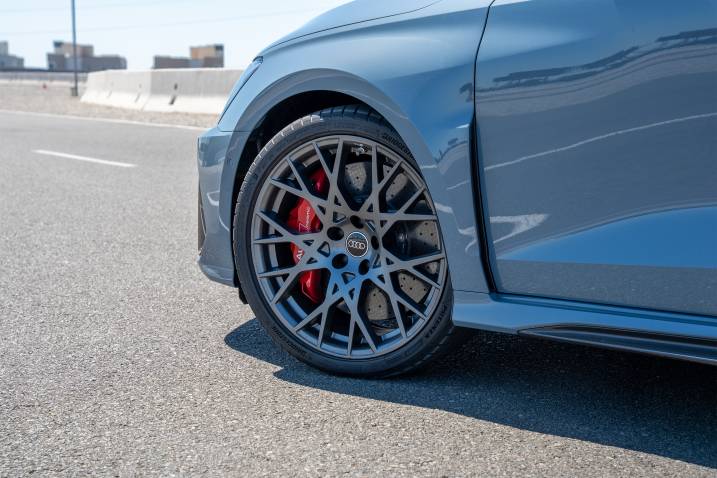
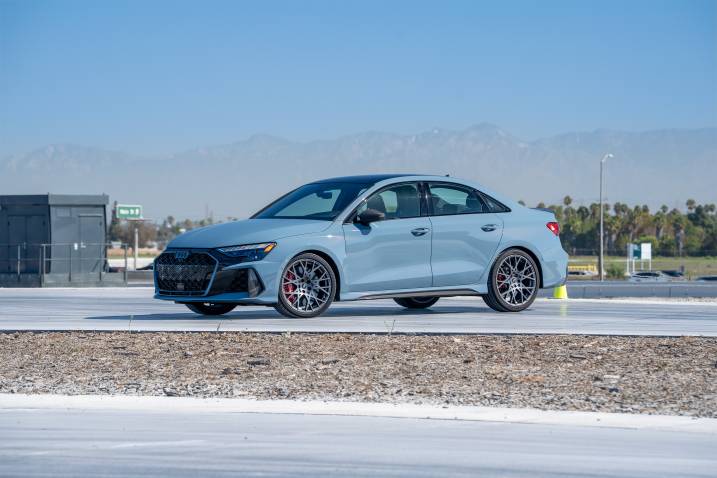
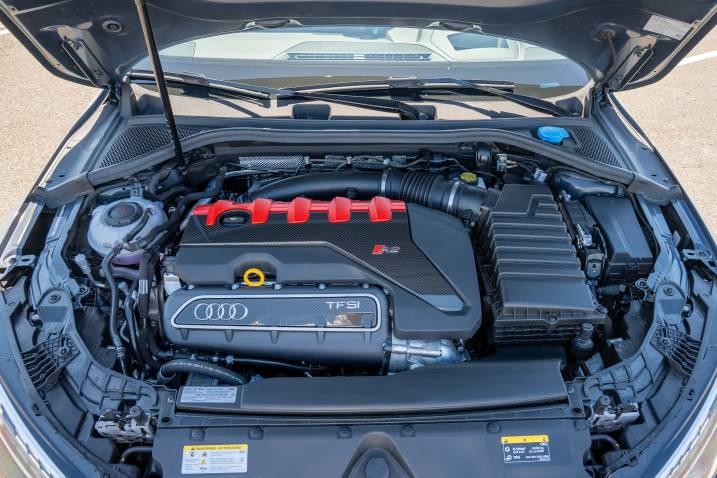
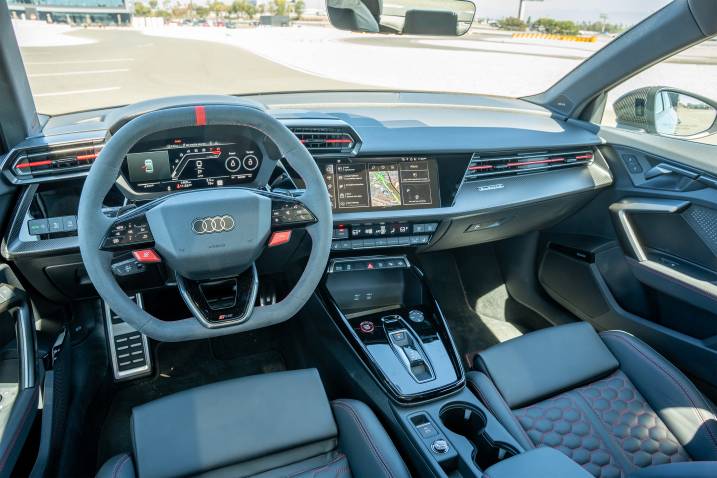
 by
by  edited by
edited by